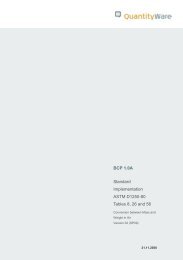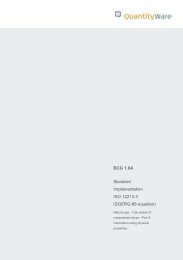QuantityWare - ASTM D1250-04_ASTM_D1250-80 comparison
QuantityWare - ASTM D1250-04_ASTM_D1250-80 comparison
QuantityWare - ASTM D1250-04_ASTM_D1250-80 comparison
- No tags were found...
You also want an ePaper? Increase the reach of your titles
YUMPU automatically turns print PDFs into web optimized ePapers that Google loves.
5.6. Result analysis - tables 53 A, B and D – 19<strong>80</strong> and 20<strong>04</strong> gridThe following table summarizes our findings for tables 53 A, B and D. The table contains the %numbers of calculations which showed a difference with respect to the total number ofsuccessful calculations performed in the respective grid. We also print the maximum differencesin absolute units (kg/m³) that we detected. More details can be found in chapter 5.1 and chapter5.2. The results for the 20<strong>04</strong> grid show the expected <strong>80</strong> % deviations, since the input densityvalues for tables 53 and 54 are rounded to 0,5 kg/m³ in <strong>ASTM</strong> <strong>D1250</strong>-<strong>80</strong>, whereas <strong>ASTM</strong><strong>D1250</strong>-<strong>04</strong> defines no rounding and the grid increment of 0,1 kg/m³ defines the accuracy as:<strong>ASTM</strong> <strong>D1250</strong>-<strong>80</strong> Table 53 :% differences found - 20<strong>04</strong> grid, within 19<strong>80</strong> rangesQuantity compared: Base density @ 15 °CA - crude oil B - products D - lubricantsall temperaturesMaximum difference (complete/90%) [kg/m³] 0,3 / 0,3 0,5 / 0,4 0,3 / 0,3complete grid 79,5% 79,8% <strong>80</strong>,0%90 % grid <strong>80</strong>,0% <strong>80</strong>,0% <strong>80</strong>,0%temperatures below baseMaximum difference (complete/90%) [kg/m³] 0,3 / 0,3 0,5 / 0,4 0,3 / 0,3complete grid <strong>80</strong>,2% <strong>80</strong>,2% <strong>80</strong>,0%90 % grid <strong>80</strong>,2% <strong>80</strong>,2% <strong>80</strong>,0%temperatures equal or above baseMaximum difference (complete/90%) [kg/m³] 0,3 / 0,3 0,3 / 0,3 0,3 / 0,3complete grid 79,3% 79,6% <strong>80</strong>,0%90 % grid 79,8% 79,8% <strong>80</strong>,0%The results for the 19<strong>80</strong> grid are given in the table below; note that we basically obtainedidentical results for the “German rounding” implementation for both the 19<strong>80</strong> and 20<strong>04</strong> grid.<strong>ASTM</strong> <strong>D1250</strong>-<strong>80</strong> Table 53 :% differences found - 19<strong>80</strong> grid, within 19<strong>80</strong> rangesQuantity compared: Base density @ 15 °CA - crude oil B - products D - lubricantsall temperaturesMaximum difference (complete/90%) [kg/m³] 0,1 / 0,1 0,2 / 0,2 0,1 / 0,1complete grid 12,6% 7,9% 3,3%90 % grid 3,7% 3,5% 0,5%temperatures below baseMaximum difference (complete/90%) [kg/m³] 0,1 / 0,1 0,2 / 0,2 0,1 / 0,1complete grid 4,6% 4,0% 0,5%90 % grid 3,6% 3,3% 0,4%temperatures equal or above baseMaximum difference (complete/90%) [kg/m³] 0,1 / 0,1 0,2 / 0,1 0,1 / 0,1complete grid 15,2% 9,3% 4,2%90 % grid 3,8% 3,8% 0,6%Comparison of <strong>ASTM</strong> <strong>D1250</strong>-<strong>04</strong> and <strong>ASTM</strong> <strong>D1250</strong>-<strong>80</strong> 29/49






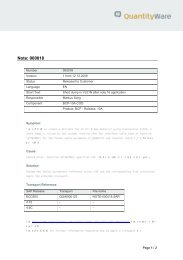
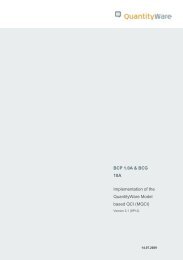
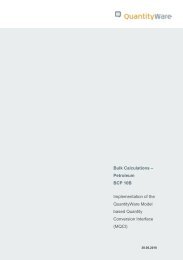

![Petroleum ASTM D1250-80 SP09 [276.9 KByte] - QuantityWare](https://img.yumpu.com/48083876/1/184x260/petroleum-astm-d1250-80-sp09-2769-kbyte-quantityware.jpg?quality=85)
![SAP QCI in a Nutshell + Notes [761.4 KByte] - QuantityWare](https://img.yumpu.com/46691308/1/178x260/sap-qci-in-a-nutshell-notes-7614-kbyte-quantityware.jpg?quality=85)


